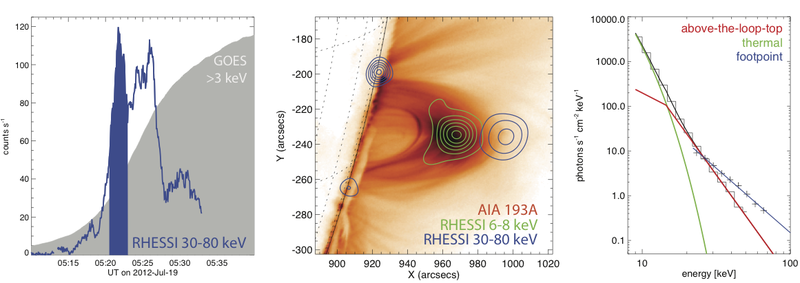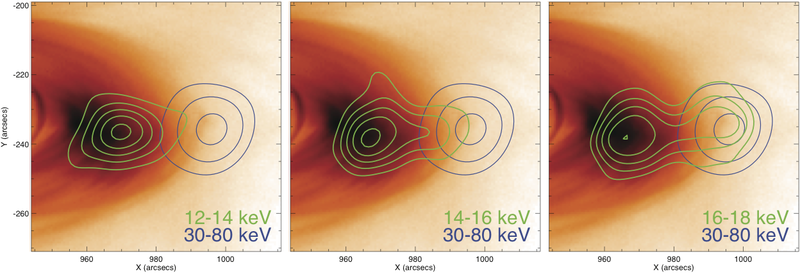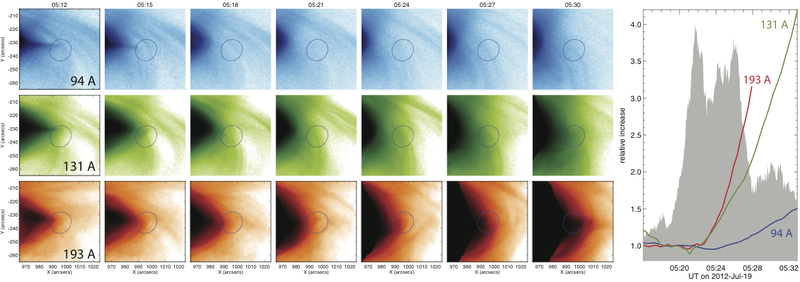Acceleration-region Densities
From RHESSI Wiki
| Nugget | |
|---|---|
| Number: | 205 |
| 1st Author: | Säm Krucker |
| 2nd Author: | Marina Battaglia |
| Published: | August 5, 2013 |
| Next Nugget: | TBD |
| Previous Nugget: | Implosion and Oscillation |
| List all | |
Contents |
Introduction
RHESSI has abundantly confirmed the importance of energetic electrons in solar flares. These electrons radiate via non-thermal bremsstrahlung, as detected and imaged in the hard X-ray (HXR) spectrum. Ultimately the energy comes from a reservoir created by the intense magnetic field in the corona, typically near a magnetic active region. Flare structures reflect the dynamics of the magnetic field as it restructures itself to create the flare (and, if powerful enough, to launch a coronal mass ejection. The first clear mapping of these processes via hard X-ray imaging came from the Yohkoh satellite, which detected the often-discussed "Masuda flare" [Ref. 1]. The interesting feature of this flare was the location of the hard X-ray emission: it was from a coronal region above the hot (soft X-ray) loops that virtually define a flare nowadays, rather than in the loops themselves. This region of the corona had no identifying features, other than the hard X-ray emission, but this was so powerful that the phenomenon immediately was taken to reflect the primary energy release of the flare, and its particle acceleration.
The Masuda flare was in 1992 (SOL1992-01-13, to give its official name), and since the launch of RHESSI in 2002 we have gradually been coming to understand more about the physics involved. Clean examples of "above-the-loop-top" emission, as in the singular case of the Masuda flare, have been rare. The event discussed here (SOL2012-07-19T05:58, M7.7) is one of the best in the RHESSI database, and it had copious supporting observation - specifically, from SDO/AIA with its wonderful images of flare structures as seen in thermal emissions.
SOL2012-07-19T05:58
The limb flare SOL2012-07-19T05:58 shows one of the most prominent above-the-loop-top HXR sources in the entire RHESSI data base (Figure 1). The coronal source is clearly visible in the 30-80 keV band for the whole duration of the main HXR peaks (05:20-05:27 UT). We illustrate the main features of this very nice event in Figure 1: time series, image, spectrum.
From the right panel of Figure 1 one can see a clear distinction between the hard X-ray spectra of the footpoint sources and the coronal source. The latter is distinctly softer, though both have spectra strongly suggesting non-thermal power laws. Note that the above-the-loop-top HXR source is a remarkable 35 arc sec above the soft X-ray loops (as seen both by RHESSI and by the Fe XXIV response in the AIA 193Å filter. This large a separation is unprecedented, observationally. Furthermore, the coronal source clearly has a greater geometrical extent than the footpoint sources do (note: the relative weakness of the southern footpoint in this case is probably due to obscuration by the limb, i.e. the southern footpoint is mostly occulted by our Earth perspective). This greater spatial extent in the coronal source is noteworthy.
To understand the relationship between the coronal and loop sources, we have used RHESSI's capability for "imaging spectroscopy." In principle RHESSI can make a monochromatic image (a classical spectroheliogram, but in hard X-rays). We show some of these in Figure 2. The region separating the coronal source and the loop appears to be hotter than the loop source itself, a possible clue to the mechanism for energy release.
Conclusion
References
[1] "A loop-top hard X-ray source in a compact solar flare as evidence for magnetic reconnection"
[2] [http://adsabs.harvard.edu/abs/2010ApJ...714.1108K "Measurements of the Coronal Acceleration Region of a Solar Flare"}
| RHESSI Nugget Date | 5 August 2013 + |
| RHESSI Nugget First Author | Säm Krucker + |
| RHESSI Nugget Index | 205 + |
| RHESSI Nugget Second Author | Marina Battaglia + |


